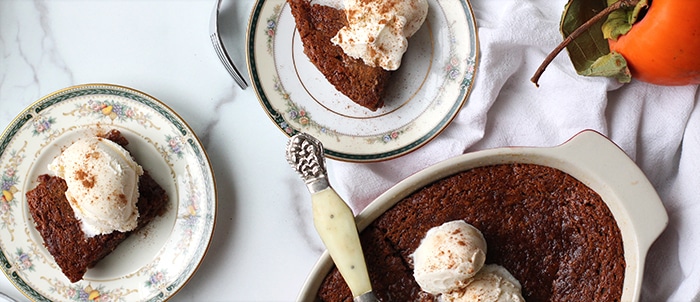Persimmon pudding is one of those old-fashioned recipes found in the cookbooks our grandmothers used to pour over with a near-religious conviction. The pages in those cookbooks were worn and tattered, splattered with sauces and smears from decades of dishes made with love. One bite of this classic dessert, and you’ll instantly be transported to simpler times. This dish just tastes like a down-home hug and it’s one you’re going to want in your repertoire.
While persimmon pudding eats like an English dessert with its sticky toffee pudding-like texture, its origins are strictly American. Delicately moist, fruity persimmons give this dessert its uniquely sweet flavor, accented with the warm spice of cinnamon.
Persimmon pudding recipe

(From Rainbow Delicious)
Most persimmon puddings, and many other dessert recipes, call for baking in a water bath. This method of baking helps a dish to cook gently, in a warm, moist environment with even heat distribution. The added moisture in the oven air also prevents the top of the pudding from cracking, and helps form a smooth, even texture to the dessert.
Ingredients:
- 1 cup flour
- 1 cup sugar
- 1/4 teaspoon salt
- 1 teaspoon baking soda
- 1 teaspoon cinnamon
- 1 cup persimmon pulp from 2-3 ripe Hachiya persimmons
- 1/2 cup milk
- 1 teaspoon vanilla
- 1 tablespoon butter, melted
- 1 egg white, whipped, but not fully stiff
Method:
-
Preheat the oven to 350F.
-
Grease a small casserole dish. Use a dish that will fit inside a larger 9 X 13 casserole dish, so that you can make a water bath.
- In a large bowl, sift together flour, sugar, salt, baking soda, and cinnamon.
- To the flour mixture, add the persimmon pulp, milk, vanilla, and butter, mixing until just combined.
- Fold in the whipped egg white.
- Pour batter into the prepared dish, and place the dish into a larger, 9 X 13 casserole dish. Add about 1 inch of water to the 9 x 13 dish, creating a water bath for the pudding dish.
- Bake for one hour.
- Allow to cool slightly before serving. Garnish with whipped cream or vanilla ice cream, if desired.



